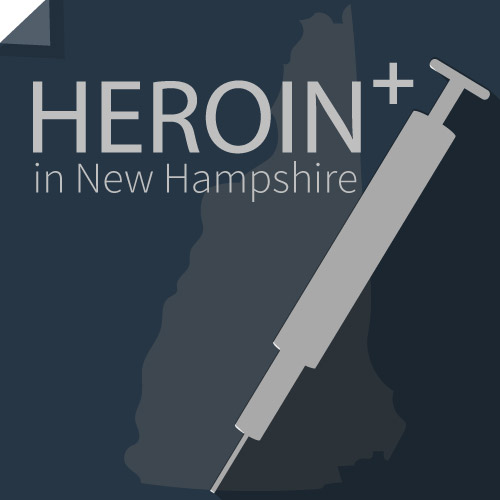
This is the sixth article in our series exploring how UNH alumni, faculty and students are tackling the heroin and opioid epidemic that has hit New Hampshire and many other parts of the country. This story reports on a panel discussion recently hosted by UNH’s Justice Studies program.
Here’s the big takeaway from a recent Justice Studies-sponsored panel discussion on New Hampshire’s opioid crisis that has killed nearly 300 people this year: No one gets up in the morning and decides to stick a needle in their arm.
That was the consensus of the panelists who spoke to an audience of mostly UNH students gathered at the MUB earlier this month. Donna Perkins, clinical associate professor of justice, organized the discussion, drawing on a pool of experts who work closely with the program.
“This is a subject that affects everyone in this room,” said David Kelley, deputy director of New England High Intensity Drug Trafficking Area, a federal agency whose goal is to disrupt drug trafficking. “The United States has about 5 percent of the world’s population, yet we consume 90 percent of all opiates in the world. It’s supply and demand.”
Melissa Silvey, director of public health and prevention with Goodwin Community Health in Somersworth, put those numbers into perspective, saying, “We are trying to build systems to deal with the issue, but it’s like using a spoon to bail out a boat that’s sinking.”
Jake Collins called the problem “a tsunami of opiates.” The assistant superintendent of education and programs at the Strafford County Jail in Dover, Collins launched the jail’s therapeutic community drug and alcohol rehabilitation initiative that has inmates with addiction issues living together, separate from the rest of the prison population, while they participate in the substance abuse program.
“Previously we had treatment and recovery facilities. There were a thousand more beds (in New Hampshire) 20 years ago than there are today.”He described the Catch-22 scenario that led to the jail starting its own treatment model: An offender with a substance abuse problem could possibly have his one-year sentence suspended if he went into treatment, but because options are so limited in New Hampshire, it rarely happened.
“They would end up serving their year before a bed opened up,” Collins said. “We shifted from total incarceration to a 90-day ‘behind the walls’ substance abuse program.”
Recovery programs help people maintain their sobriety, John Wozmak, New Hampshire’s senior director of substance misuse and behavioral health told the audience. “Previously we had treatment and recovery facilities. There were a thousand more beds (in New Hampshire) 20 years ago than there are today.”
To help bridge the gap, several Granite State communities are in the process of opening recovery centers like the HOPE Recovery Community Center in Manchester, which offers support to recovering addicts and their families. Silvey said two locations for similar facilities in Somersworth are currently being discussed.
“Everyone thinks treatment means getting a bed, but an intensive 28-day, 90-day inpatient program isn’t enough. Opiate use rewires the brain,” Silvey said. “People need resources when they come out of rehab."
And communities need help understanding and then supporting people with opioid addictions, she added.
“It starts with a prescription,” Silvey said. “It doesn’t start with ‘I’ll stick a needle in my arm today.’”

But, too often, that is the devastating consequence of prescription drug abuse; experts contend misuse of pain medications can serve as a springboard to heroin addiction. Wozmak noted that 19 out of 30 pain pills go unused by the person for whom they were prescribed.
“It’s difficult to prosecute doctors for overprescribing,” Wozmak said, while Silvey, referencing lawsuits against the tobacco industry for not making smokers aware that cigarettes are addictive, said, “Where is the responsibility of the pharmaceutical companies that aren’t testing these drugs enough or aren’t educating doctors about how addictive they are? Where are those lawsuits?”
Captain David Kretschmar, investigations division commander with the Somersworth Police Department, said the city has had 99 drug overdoses this year, 10 of which were fatal.
“If we couldn’t have brought them back with Narcan (a prescription drug used to reverse the effects of opioid overdoses), there would have been 99 dead,” he said. “One in 100 people are overdosing — that’s one of you in this room.”
Kretschmar, who has been with the Somersworth department for 32 years, noted there are cycles for illegal drugs, with cost and access impacting what is in demand at a given time. Cocaine, crack, crystal methamphetamine, Oxycontin have all had their day, he said. The difference is that people don't die as often from the other drugs, he said. “Right now, heroin is cheap and easy to get. And it’s killing a lot of people.”
But that wasn’t the case until recently. According to Kelley, New Hampshire had fewer than 10 heroin overdoses a year between 1993 and 2007. In 2014, 321 people lost their lives to opioids. The state medical examiner has said he expects that figure will be surpassed before 2015 ends — a fact that isn’t surprising when you consider this, offered by Wozmak: “There are at least 400,000 doses of heroin coming into the state every day.”
In the end, the discussion came back to the fact that addiction is a disease and the addict needs help getting that disease into remission. As Wozmak said, “No one makes a conscious decision to destroy every single aspect of their life.”
-
Written By:
Jody Record ’95 | Communications and Public Affairs | jody.record@unh.edu



















































